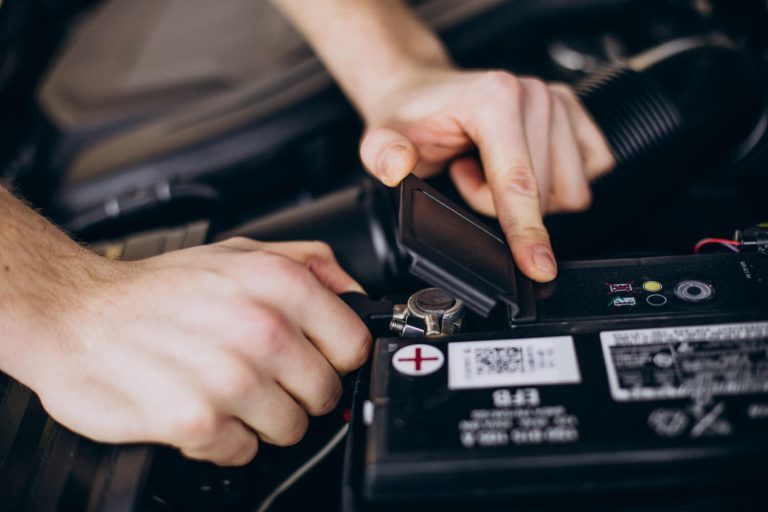A type of onboard diagnostic capacity is present in the majority of vehicles on the road today. It means that when something goes wrong with the car, a light on the dash will alert the driver. One of the most common diagnostic lights is the check engine light. There are several possible causes for the Check Engine Light on After Battery Change.
Simple problems like loose gas cap can occasionally cause problems, but other times it might be something more serious like a broken engine sensor. If you’ve ever had your car’s battery die and had to replace it, you may have noticed that the check engine light comes on after the battery change. This is perfectly normal, and there’s no need to worry. I am writing this article explains why this happens and how to reset the light.
After a battery replacement, the check engine light can illuminate due to a loose or flawed connection. Loose battery terminals are the most frequent cause. A voltage loss caused by the loose terminal could cause the check engine light after battery change. The car’s computer controls the check engine light, which is under the hood. The computer loses power and certain settings when the battery is disconnected.
The good news is that the light usually goes off independently after a few miles of driving. If it doesn’t, you may easily reset it by unplugging the battery for a short period of time, and then plugging it back in.
Table of Contents
ToggleWhy Check Engine Light On After Battery Change
Trouble Codes
After changing the battery in your car, if your check engine light is still on, you probably need to clear the codes. The check engine light is intended to illuminate when the computer identifies a problem and frequently remains illuminated until the issue has been resolved. In this case, the computer must be reset after the battery change.
To erase the codes, you’ll want a code reader or scanner. You can buy these reasonably priced gadgets in many auto parts outlets. To clear the codes after you have the gadget, follow the directions. Most of the time, this entails attaching the device to the vehicle’s diagnostic port and following the on-screen instructions. The check engine light ought to go out once the codes are erased.
Damaged Battery Terminals
It is the most common cause behind the engine light on after battery change. When the battery terminals are damaged, a false connection is established between the battery and the electrical system of the car. It will result in the check engine light activation and a false code generation.
If you have changed your car’s battery, but the check engine light is still on, then the terminals of your new battery are likely damaged. To fix this, clean the terminals of your new battery with a wire brush and see if the check engine light is activated.
Faulty Battery Connections
If your car’s check engine light on after changing battery, the battery and electrical system are likely not correctly connected. It will result in the same false code generation as in the case of damaged battery terminals. To fix this issue, inspect the battery terminals and see if they are loose.
If so, tighten it with a wrench and see if the problem is solved.
Loose Battery Cable
If the battery cable is loose after you have changed the battery of your car, then it will result in the check engine light activation. A loose battery cable will result in a false connection between the battery and the electrical system of the car. It will result in the check engine light activation and a false code generation.
The cable is loose if your car’s battery has been replaced, but the check engine light is still on. To fix this, check the battery terminal and the black cable of the battery. If any of them is loose, tighten it with a wrench and see if the check engine light is still on.
Incorrect Battery Installation
If you have installed the battery in your car incorrectly, it will activate the check engine light. When you install the battery in the incorrect direction in your car, a false connection is established between the battery and the electrical system of the vehicle.
It will result in the check engine light activation and a false code generation. If you replaced the battery in your car, but the check engine light is still on, you could not have fitted it properly. Please remove the battery and correctly reinstall it to resolve the problem. It must be installed in the exact direction.
Solution
If your car’s engine light illuminates after you replace the battery, you can attempt a few things to resolve the issue. First, check all connections and ensure that the battery replacement is perfect. If the light is still on, turn on your car engine and let it idle for a few minutes to complete ECU relearning after battery replacement. If still unresolved, the best thing to do is use a code scanner to check the trouble code. After that, search online for the code provided by the scanner. If the issue is minor, try to resolve it on your own; if it’s a mechanical problem, contact a professional immediately.
Also Read: How Long Can You Drive Without A Muffler
Frequently Asked Questions
How to reset check engine light after battery change?
If your check engine light turns on after you change the battery, there are a few steps you can take to reset it. You may need a code reader or drive cycle computer to reset the light. Check your car’s owner’s manual for specific instructions. In most cases, however, you can disconnect the negative battery terminal for about 30 seconds and then reconnect it.
This should reset the light. If the light does not turn off after doing this, you may need to take your car to an auto shop to have it checked out. No matter the reason, it is important to know why the check engine light came on and take the necessary steps to ensure your car continues to run properly.
Is it safe driving a vehicle with the check engine light on?
Most people have experienced the fear of having their car’s check engine light come on. After all, it’s never good news when a warning light comes on, and the check engine light is one of the most ominous-looking. But what does it mean? Is driving safe with the check engine light on, or should you pull over and call a tow truck immediately?
The check engine light can be an indication of many different conditions, some important and some not. Even if it’s not an emergency, most of the time, it still needs to be handled right away. As soon as you detect the check engine light going on, ensure sure your engine oil is full.
The light might be on because it’s low; topping it off should make it turn off.
If the oil level is satisfactory, the next step is to check for loose or damaged wiring under the hood. A loose connection can sometimes cause the check engine light to come on. If you find any damaged wiring, it’s best to have it repaired by a professional.
Will you disconnect the battery and clear the check engine light?
The majority of individuals mistakenly believe that disconnecting the battery will turn off the check engine light. When there is a problem with the your car’s emissions system, the check engine light is intended to illuminate. Normally, the light will turn on when the automobile first starts and turn off after the engine has been running for a while. If the light doesn’t go out, something needs to be fixed.
Disconnecting the battery will not clear the check engine light. It may make the problem worse. When you disconnect the battery, you lose all the data stored in the vehicle’s computer. The computer uses this data to monitor the emissions system. If the data is lost, the computer cannot properly monitor the system, and the check engine light may come on again.
The best course of action if your emissions system is acting up is to take your automobile to a repair and have it looked at. They’ll be able to detect the issue and resolve it. It’s preferable to leave the problem to the experts because attempting to solve it could make it worse.
How long does the ECU relearn after a battery change take?
The ECU will usually relearn within a few minutes or less. The length of time the ECU needs to relearn can be impacted by a few factors, though. One is the type of battery you have. If you have a standard lead-acid battery, it will take longer for the ECU to relearn than a lithium-ion battery. It is because lead-acid batteries have a higher self-discharge rate, which means they lose power faster than lithium-ion batteries.
Another factor affecting the relearning time is how long the battery was disconnected. If you only disconnect the battery for a few minutes, the ECU will relearn quickly. However, if you disconnect the battery for an extended time, the ECU will take longer to relearn. This is because the longer the battery is disconnected, the more time the ECU forgets its previous settings.
How can I retrieve check engine light codes without an OBD-II scanner?
There are some ways to get the codes even if your car doesn’t have an OBDII scanner and the check engine light is on. One way is to use a paperclip. Insert the paperclip into the connector (usually under the dash) and count the flashes. The number of flashes will correspond to a specific code.
Utilizing a digital multimeter is another option. Set the multimeter to the “diode test” setting and touch the positive lead to the connector and the negative lead to the ground. Again, count the number of flashes to determine the code. You can also download an application that enables you to read the codes without a scanner if you have access to a laptop. It will require an adapter that connects the OBDII port to the laptop.







